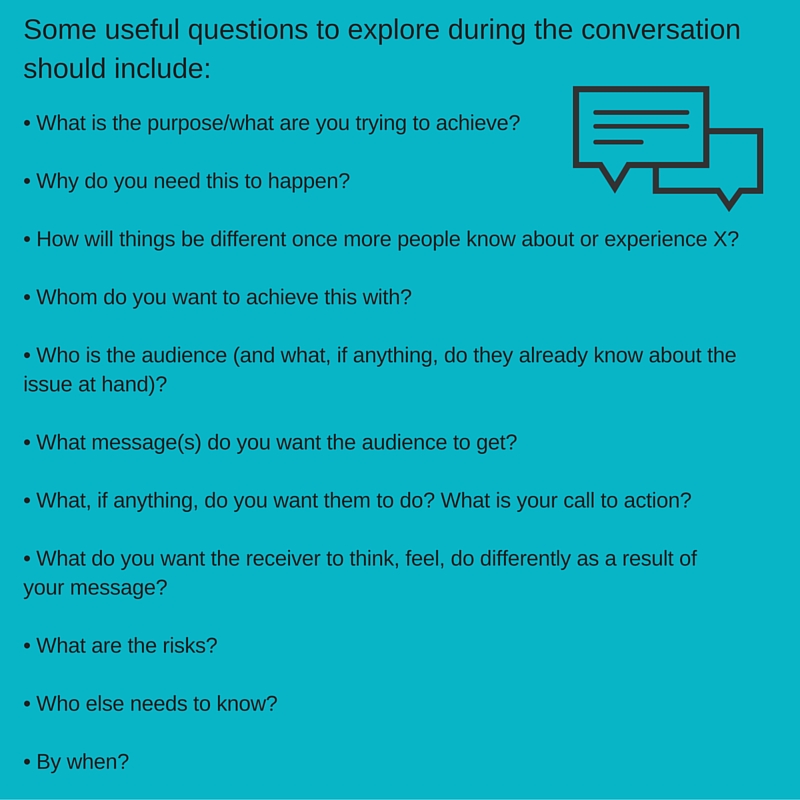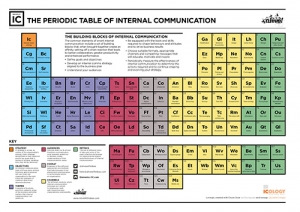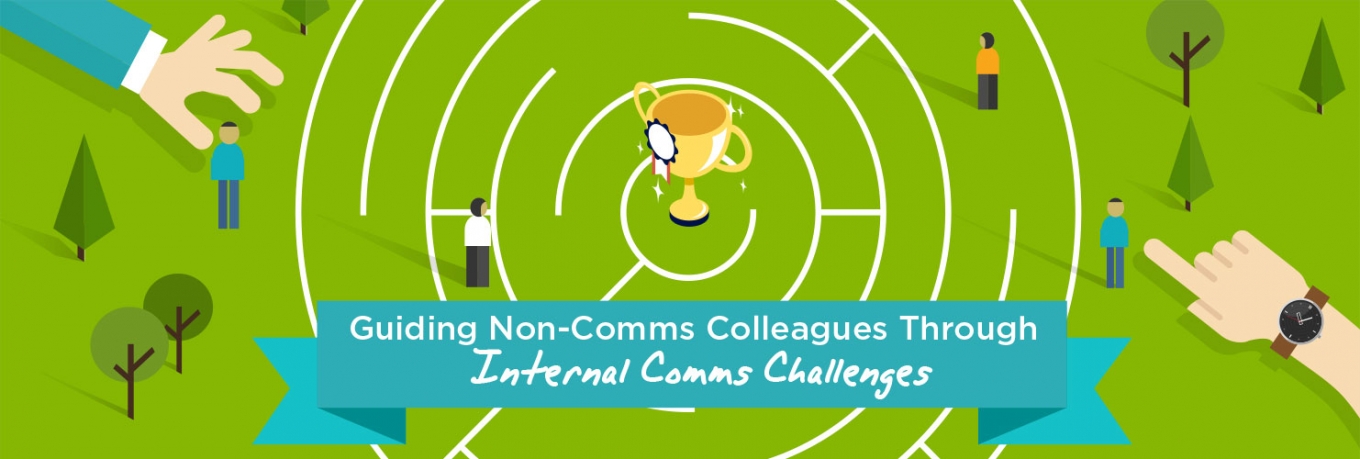As an internal communicator a crucial part of your role is likely to be supporting and guiding a colleague through a comms challenge. They want your insight and expertise. That’s why they’ve asked for your input, isn’t it?
So when someone approaches you, how do you guide them through the ever-evolving world of comms? What do you get them to think about? And what is the opportunity for you personally and the comms team?
Without following a logical process, how can we be sure we’ll be achieving the right result? And how can we help our colleagues to understand some of the complexities of corporate comms, guiding them along the path to a successful outcome for all involved?
Rather than simply delivering the goods (or battling for alternatives and a more appropriate option), we could be saving ourselves a lot of time and energy in the long run with a few well-considered questions and some useful resources…
Shaping how comms can help
Requests like the all-employee email are pretty standard but often come from people within the business who aren’t necessarily skilled in the art of effective internal communication. They may not entirely understand what’s involved. Urgency and priority for example, what other comms are in the offing, what could they clash with, what messages could they be combined with to make a greater impact? And so on.
The shifting role of an internal communicator means that responsibilities not only include ‘creator’, ‘information disseminator’ and curator but will also involve the role of ‘facilitator and coach’ – guiding colleagues, stakeholders or ‘internal clients’ through a process to communicate messages in the right way, to the rightpeople at the right time – ensuring that the communication achieves its objective. In order to do this, it helps to have a reliable structure to follow. Sounds like there’s more to this than uploading content to the intranet or clicking send on the all employee email…
Input from our network
We consulted our network to ask how they support colleagues with their comms requests. We asked, ‘When approached by a colleague from a different business function with an internal comms challenge, what are the typical questions you would ask and how would you guide them through the conversation? Do you have a process that helps you both to understand and tackle the challenge effectively?’
We had a keen response and we’re hugely grateful for all the input.

Everything else will very likely flow from the answers to these questions.
Other useful thoughts/tips/best practice ideas
- What is their overall objective? Inform, consult, engage, change behaviour, etc.? Sometimes we get caught up in the need to get a message out that we lose sight of the why behind the communication itself. If you clearly understand your objective(s) it helps you determine the best overall approach to how you’ll communicate.
- Agree key messages -Before communicating anything it’s important to agree the key message, who the audience is, and why that message is relevant to them.
- Align with business goals – Check how the challenge/objective aligns with corporate strategy and internal market research before galloping ahead with any actions.
- Stand firm – Never be bullied into the ‘It must be emailed to all staff’ as this really isn’t always the solution.
- Know the culture – Be sure you have a thorough understanding of what the culture is like within the business function in order to better brainstorm/share ideas and past positive experiences. While most companies have an overarching corporate culture, oftentimes business units or functions have their own sub-cultures that are influenced by their leader’s (and leadership team’s) style.
- Try the OASIS planning model – Encourage your colleague to identify and confirm their objectives (ie. what they want to achieve); confirm who their audience is and what they know (or need to know) about them; discuss the ‘What’, ‘Where’, ‘When’, ‘Why’ and ‘How’ they’d like to go about it (including tactics/channels they would like to use (which may not be the same as those you’d advise!) and agree what success might look like.
- Or the ABCDE model –
- Ask them to consider who their audience(s) is/are;
- What their objectives are (what do they want their audience(s) to know, feel and do);
- What their key messages are;
- Answer the essential ‘When’, ‘How’ and ‘Who’ questions (ie. preferred tactics/channels, key dates and who will have responsibility for doing what)
- How we can evaluate the effectiveness against the original objectives.
- Or the ARROW method from Sue Dewhurst –
- AIM: what is the goal of the programme/project they want to communicate about? What does success look like?
- REALITY: what is the current situation? How do things work now and what would go wrong if nothing changed, if nothing were communicated?
- ROADBLOCK: where are the obstacles to success? Perception, approvals, budget, etc.?
- OPPORTUNITIES: what else is happening that the communication might be linked to?
- WHO, WHAT, WHERE, WHEN, HOW: it’s easy to jump directly to this step – the logistics of what will be communicated by whom and when, but it really should be informed by a discussion of the above points.
- Or the COMMS framework from Jonathan Champ –
- CONTEXT: What is going on now, for whom? Why? What happened before?
- OUTCOME: What is the desired change? How will you know (measurement)?
- METHODS: Based on considering the current situation, outcomes, and available approaches.
- MESSAGES: Key messages to support the outcomes – what needs to be conveyed? (which *might* not be what they want to say).
- SUPPORT: Who and what is involved in making this happen? – other resources, budgets, tools, processes to embed.
- Or the 5i’s template from Priya Bates – that will take you from writer to strategist (program available through IABC Academy). It asks questions on:
- IMPACT(what does success look like)
- INFLUENCE (who needs to deliver the message)
- INTEGRATE (what else is going on)
- INTERACT (who is your audience)
- IMPLEMENT (what timelines, budget, tools).
- The five questions approach –
- In 25 words or fewer, what are you announcing? What’s happening? What’s the news?
- When would you like to announce this to your audience(s)?
- How do you think your audience(s) partners will react, and why?
- Why is this news important to the company and the division?
- Will your project/news be consistent globally? If not, how will it differ by area – at a high level?
- Change the Conversation – This article from Priya Bates of Inner Strength Communication shares some excellent insight into managing the conversation with non-comms colleagues. It’s well worth a read – What if we Changed the Conversation for Communication Success?
- Create a Channels Matrix – Ensure you have a Channels Matrix that you can refer to and share so you can demonstrate alternative options and their particular strengths.
- ‘So what?’ A communication to all staff is usually what’s requested, but is not always the appropriate method. By asking “so what?” you can help avoid over communicating and create more effective messaging.
- What NOT to say – Consider and discuss what you DON’T want to communicate as well as what you do.
- Set expectations – It’s important to express to clients that communicating effectively is not an overnight process. Help them look at the long-term, holistic picture. Build a plan before talking tactics.
- Priorities – Is this a communication that’s likely to go external? If so stress the importance of timing and ensuring employees know the facts before they go public.
- What’s the alternative? Consider the fact that there may not be a comms need at all and the challenge may need to be addressed in a different way.
An excellent collection of tried and tested tips and best practice ideas from a number of internal comms pros – a big thanks again to all those who contributed to the LinkedIn chats with their valuable thoughts and experiences. The conversations are ongoing, and you can follow them here:
Melcrum Communicators Network, Internal Communications Best Practices and IoIC – The Institute of Internal Communication.
How can this help you and the comms team?
It’s obvious to say but worth thinking about that (almost) every time a colleague needs your support there’s an opportunity to demonstrate your own personal expertise and that of your team. Building your reputation as someone that knows how to get the most from a particular challenge can put you in the driving seat for the future and reshape the perception of the team, if required.
A resource for all – comms or not
 We recently published The Periodic Table of Internal Communication which introduces The Elements of IC – a new online resource that we’re in the process of creating. In much the same way as those suggestions above, The Elements of IC will help to facilitate conversations, spark ideas and tackle comms challenges. We’re delighted with how it’s been received so far by comms folk around the world.
We recently published The Periodic Table of Internal Communication which introduces The Elements of IC – a new online resource that we’re in the process of creating. In much the same way as those suggestions above, The Elements of IC will help to facilitate conversations, spark ideas and tackle comms challenges. We’re delighted with how it’s been received so far by comms folk around the world.
What’s been particularly heartening is the positive feedback we’ve had from people who aren’t in a traditional ‘comms role’ (that may be people working in HR, marketing, learning and development, health and safety, etc.) in particular, how the resource will help to start conversations and prompt new thought processes.
Our intention is that this resource will provide a practical process to follow and to guide others through – from addressing goals within the strategy to clarifying objectives, agreeing desired outcomes, determining audiences, exploring different formats and channels for the messaging and ultimately measuring the success of the communication.
In summary
Shaping how comms can help the business and its many functions is a crucial part of our role. We may be approached with one request that can transform into something entirely different when we take the bigger picture into account. If we can find and employ practical tools, prompts and resources to help our colleagues understand this and adopt a different mindset, we ultimately create a much more streamlined and effective organisation.
It generally comes down to a case of starting conversations and dialogue rather than emails and campaigns.
One final point to consider. In an ideal world, advice will be heeded and support will be well received, but we know this won’t always be the case. So what if others insist on a certain way of doing things? Disregard advice and choose to execute their own communication campaign regardless? We’d love to hear your experiences. How have you managed challenges like these? Tweet us @Alivewithideas with your thoughts.
















